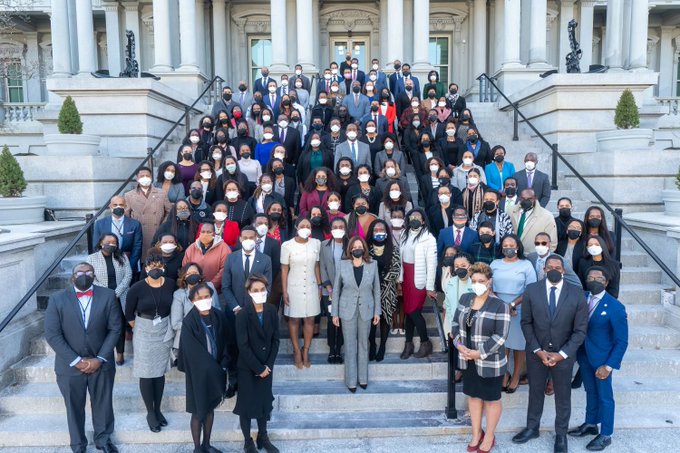Blacks in Cabinet Gather for Black History Month
Journal-isms Roundtable Goes ‘on the Road’
Puerto Rican Journalist Seeks to Withhold Source
Let ‘The Last Slave Ship’ Inspire Journalists;
Saga Touches on Today’s Hot-Button Issues
Homepage photo: Black staffers at the White House take a picture for Black History Month on Feb. 4 (Credit: The Grio)
Support Journal-ismsBlacks in Cabinet Gather for Black History Month
In an echo of the Cold War and earlier eras, when adversaries capitalized on racial issues in the United States, Linda Thomas-Greenfield, the U.S. ambassador to the United Nations, said Thursday that when she is abroad, “We talk about issues of racial justice, and that is extremely important for me because it’s an issue where people think we are weak.”
Thomas-Greenfield was speaking at a White House discussion among President Biden’s six Black Cabinet appointees, staged in cooperation with The Grio for Black History Month.
Thomas-Greenfield continued, “And so they think they can criticize us on racial justice issues. And so I have been very, very clear. We do have issues. I can acknowledge those issues.
“The vast majority of other people don’t acknowledge their problems and I don’t think China would acknowledge that they have huge human rights violations taking place in China.
“I can acknowledge U.S. weaknesses but also talk about what we’ve done to accomplish dealing with those issues, including having us around the table,” she said, gesturing to the group.
Race relations in the United States have long been intertwined with international issues. During World War II, the Black press launched a “Double V campaign,” asking why African Americans, after fighting racism abroad, should face Jim Crow at home.
The “avowed Soviet commitment to racial equality and global anti-racism still had the power to inspire ordinary Black Americans in their struggle against Jim Crow and in their global pursuit of Black liberation,” reads one account of the Cold War.
During the Vietnam War, Muhammad Ali famously was quoted as saying, “No Vietnamese ever called me n—-,” even if he didn’t use exactly those words.
The tables were turned, however, after the George Floyd murder in the United States in 2020, when activists abroad were inspired to protest police abuse of Blacks in their own countries.
And perhaps most significantly, civil rights concerns played a large part in passing the 1965 immigration reform act, steering the nation’s demographics toward the multiculturalism that exists today. The law radically shifted U.S. policy away from selecting immigrants by national origin, favoring those from northwestern Europe and tightly restricting entry from Asia, Africa and the Caribbean.
Leading up to the change, a 1952 report from a Truman administration commission had cited liberal democratic creeds and the scientific rejection of racism, arguing that ethnically discriminatory immigration policies impaired U.S. foreign policy.
The Grio was chosen to stream the historic gathering, according to a White House spokeswoman, because “We look for every opportunity to partner with media outlets to ensure we’re reaching communities across the country.
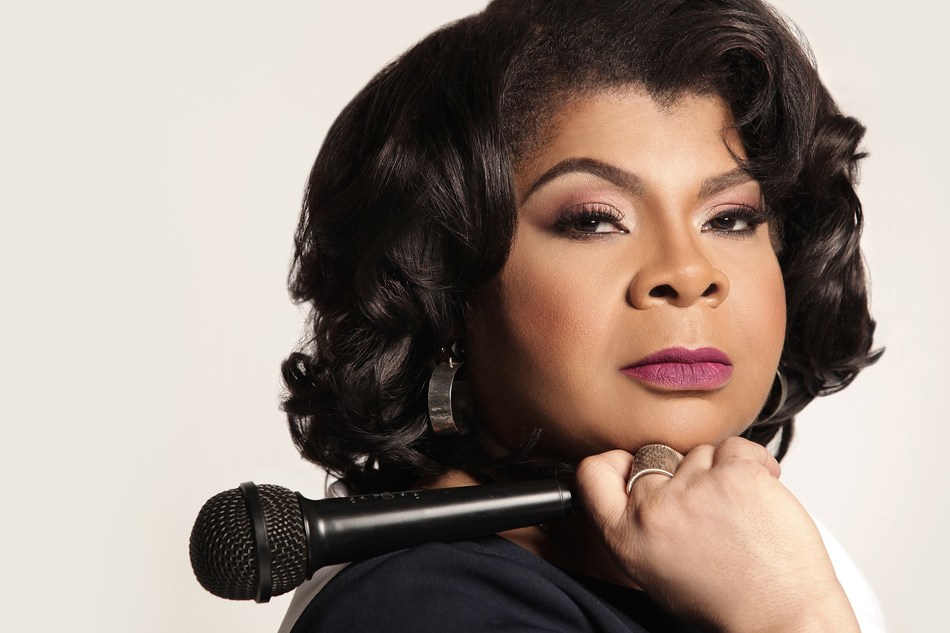 “April Ryan (pictured) is a longstanding White House correspondent and based on her consistent coverage of issues impacting the Black community, we thought it would be an excellent opportunity to partner for this historic convening.” Ryan, who joined the Grio in January 2021, celebrated 25 years as a White House correspondent last month.
“April Ryan (pictured) is a longstanding White House correspondent and based on her consistent coverage of issues impacting the Black community, we thought it would be an excellent opportunity to partner for this historic convening.” Ryan, who joined the Grio in January 2021, celebrated 25 years as a White House correspondent last month.
Participating were Defense Secretary Lloyd Austin, Marcia Fudge, secretary of the Department of Housing and Urban Development, Michael Regan, Environmental Protection Agency administrator; Thomas-Greenfield; Shalanda Young, acting director of the Office of Management and Budget; Cecilia Rouse, who chairs the Council of Economic Advisers, and moderator Cedric Richmond, senior adviser to the president. Richmond said the number should really be seven, counting Vice President Kamala Harris, who is African American and Asian American.
Thomas-Greenfield said she carries four pillars of Biden’s policies when she is abroad: COVID, climate change, issues of racial inequities and racial justice, and economic recovery. They all are issues in which Americans’ fates are linked with those abroad, she said. “When I travel overseas, I always make sure that I am there to receive COVID vaccines that the United States is contributing, because we know that we cannot address this pandemic here in the United States if we don’t address the issues overseas.”
These Cabinet members’ Blackness differentiates them from other Cabinet members in several ways, they said. Citing the aphorism that Blacks have to be twice as good, Young said, “I hope I don’t have to give that speech” to her daughter. Speaking of her position, she said, “I want this to be normal for them, not something she sees as an exception to the rule.”
Regan, a native of Goldsboro, N.C., said, “I’ve had to reach for an inhaler on a high-pollution day, Fudge said she would soon produce a report on bias in the housing appraisal process. Austin said he did not want to be the last African American secretary of defense and listed diversity and inclusion as high priorities. Richmond said he went to Morehouse College “because that’s where Dr. [Martin Luther] King went, and because it produced “strong Black men.”
Some spoke of the Southern towns where they grew up, the isolation of being the “only,” and the influence of their grandmothers.
Richmond asked each to name a public figure who had influenced them, though not all had a chance to answer:
Fudge named Barbara Jordan, legendary member of Congress from Texas known for her questioning during the Watergate scandal.
Rouse chose Dr. Ruth Simmons, first Black woman to lead an Ivy League college, Princeton. Simmons was part of a team that hired her.
Austin named Henry O. Flipper, the first African American to graduate from West Point, “a great role model” and native of his hometown, Thomasville, Ga.
Young cited Michelle Obama, “the epitome, who took a lot of flak for just being herself.”
The session was followed by a panel discussion on mental health and wellness in the Black community.
Journal-isms Roundtable Goes ‘on the Road’
A piece of the Journal-isms Roundtable went on the road Wednesday, at least electronically, with cartoonists Ray Billingsley and Barbara Brandon-Croft joining moderator Richard Prince for a digital conversation with Denver station KUSA-TV.
Billingsley, who draws the “Curtis” comic strip, was named cartoonist of the year by the National Cartoonists Society, the first Black winner in the society’s 75-year history.
Billingsley and Brandon-Croft joined a multicultural cartooning group — Lalo Alcaraz, Hector Cantú, Walt Carr, Rob King, Angelo Lopez, Marty Two Bulls and Josh Neufeld — at the Jan. 23 Roundtable.
Billingsley, 64, told the Denver audience, “When we were starting,” we thought “it would break the barriers and then bust the doors wide open . . .
“We cracked the door open and we’re peeking through, but it’s like we’re stuck in that doorway. We haven’t gone through all the way yet, and it’s still a struggle.”
Brandon-Croft, who draws the strip “Where I’m Coming From,” said little has changed in the topics she addressed and those her late cartoonist father, Brumsic Brandon Jr., did 30 years ago. “You know . . . police brutality, housing, gerrymandering, voter rights . . . .”
“STILL: Racism in America, a Retrospective in Cartoons,” an exhibit of the work of Brandon-Croft and her dad, whose “Luther” comic strip was syndicated from 1968 to 1986, is to run May 21-Oct 23 at the Billy Ireland Museum and Library at Ohio State University. Its run began in New York but was cut short by the COVID pandemic.
“We make the only father and daughter cartoonists to be syndicated in the mainstream press,” she said.
A collection of Brandon-Croft’s cartoons is to be published in 2023.
The interview is posted on the KUSA site, and on YouTube and the Roku and Fire TV apps. “We are also working on a written article to accompany the video,” Amanda Kesting, executive producer of digital video, messaged Journal-isms. “We do digital video interviews often for what we call our ‘Watch’ platforms. . . . Chris Bianchi,” who conducted the interview with the cartoonists, “is a digital anchor who does digital headline updates, weather forecasts, extended interviews, townhalls, etc. for Watch multiple times a day.”
The Tegna station attracted unwanted attention last year when Lori Lizarraga wrote for the alternative newspaper Westword under the headline, “LatinXed: 9News Got Rid of Three Latina Reporters This Past Year, Including Me.” The National Association of Hispanic Journalists paid the station a visit, and in August KUSA appointed Jesse Ogas to the newly created position of executive director of social responsibility and community affairs. Ogas and Berenice Nelson, race and culture journalist intern, helped arrange the session.
A Roundtable featuring photojournalists of color is scheduled for Feb. 27.
- Journal-isms: ‘The White Gate-Keeping Battle Is Real’ (Jan. 27)
Puerto Rican Journalist Seeks to Withhold Source
A Puerto Rican journalist has asked the Supreme Court of Puerto Rico to revoke a Court of Appeals order that he reveal the identity of a source.
 The National Association of Hispanic Journalists is considering whether to join journalists on the island in backing reporter Alex Delgado (pictured).
The National Association of Hispanic Journalists is considering whether to join journalists on the island in backing reporter Alex Delgado (pictured).
David Cordero Mercado, an NAHJ board member whose jurisdiction includes the island, raised the issue at the board’s Jan. 29 meeting.
Cordero messaged Journal-isms, “The court case in question has the potential for a transcendental and negative impact on the work of all journalists in Puerto Rico, which is why I consider important an expression framed in the defense of the privilege of journalists not to disclose their sources, and the importance of that premise within the constitutional protection of freedom of the press and of any democracy.”
According to Barbara J. Figueroa Rosa, reporting Jan. 20 for the Spanish-language Primera Hora, “Delgado anticipated that he would assume the consequences of an arrest or fines if he fails to reveal his source, since he made a confidentiality agreement with the source.”
Delgado “went to the Supreme Court of Puerto Rico to show opposition to revealing the identity of a source who provided him with a document from the Special Investigations Bureau (NIE ) for a report published in 2018 that investigated employees of the Electric Power Authority (PREPA) who allegedly received money in exchange for some certifications to restore the energy service to subscribers affected by the scourge of Hurricane Maria. The Court of First Instance and the Court of Appeals ordered the journalist — at that time Wapa’s vice president of news – to reveal the source. Wapa is also known as Noticentro.
The Overseas Press Club of Puerto Rico acknowledged that there is no statutory privilege that protects the professional secrecy of journalists, El Vocero of Puerto Rico reported. “However, preventing the disclosure of the identity of a source is an ethical duty that in some cases is contemplated in the collective agreements that shelter journalists in their workplaces and that every journalist must be willing to defend to the last consequences,” said the OPC president, Luis Guardiola.
Let ‘The Last Slave Ship’ Inspire Journalists
Feb. 7, 2022
Saga Touches on Today’s Hot-Button Issues
Homepage photo: Jeffrey Isaac Greenberg 19+ / Alamy Stock Photo
Support Journal-isms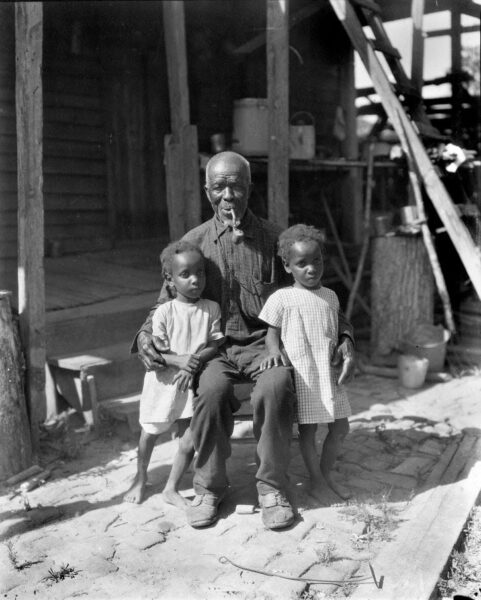
Saga Touches on Today’s Hot-Button Issues
It would be difficult to find a subject that touches on so many hot-button issues this Black History Month than “The Last Slave Ship: The True Story of How Clotilda Was Found, Her Descendants, and an Extraordinary Reckoning.“
It’s a just-published book by journalist Ben Raines, who was fired by his own newspaper, already two-thirds gutted by layoffs. The paper him go in a dispute over Raines’ pursuit of the last slave ship to bring enslaved Africans to the United States.
“In their speed to get control of the story, they lost any connection to it,” Raines told Journal-isms in a telephone interview.
Raines is a son of former New York Times Executive Editor Howell Raines. In pursuing his project, the younger Raines benefited from his training as a river guide, a sideline while being a reporter. He later found the Clotilda, buried in an alligator-filled swamp a mere 2½ miles from the newsroom of the Mobile (Ala.) Press-Register, the newspaper that fired him.
Once Raines thought he had found the ship. He reported so, with the appropriate hedging. When it turned out not to be the right ship, a descendant of the enslaved gave Raines a hug and sang a gospel song in his ear, “There’s a bright side somewhere/Don’t give up until you find it.” He didn’t.
This is a saga not only about slavery, but about environmental racism, state-sanctioned Jim Crow, relations between Africans and African Americans, reparations, politics in Africa, and the rewards of plain old grit and perseverance.
“The heroes of this story are the enslaved Africans who survived slaughter and bondage to build the first autonomous African-American community in America, beginning days after the end of slavery,” Raines writes.
The story is not over. Will the residents receive their just rewards after being victimized for more than a century?
Will the African space where they all originated — now the country of Benin — come to terms with its role in the slave trade?
There is competition to tell the story — a National Geographic project (video) premieres on Monday, based on a 2008 book by historian Natalie S. Robertson. A film co-produced by Ahmir ‘Questlove’ Thompson debuted two weeks ago at the Sundance Film Festival. “Everyone wanted a piece of the story and they were trying to get it any way they could,” Raines told Journal-isms.
Yet this is the kind of subject that would be banned in public schools, were a growing number of Republican-controlled Legislatures to call the tune.
The documented cruelty and dehumanization would make many “uncomfortable,” those legislators’ criterion for whitewashing America’s racial history under the false guise that it promotes “critical race theory.”
Still, in order to impart accurate information to the public, journalists themselves must be educated. An hour-long interview with Raines that aired on C-SPAN is a good introduction.
Ben Raines told his Facebook followers on Feb. 2, “C-Span had me on for an hour talking about The Last Slave Ship. It was the most expansive interview I’ve done related to Clotilda, and touches on the willful destruction of Africatown by city and state officials, what happened on the other side of the Atlantic during the era of enslavement, and how to honor the powerful legacy of the Clotilda captives. (Hint: dig up the ship and put it on display in a world class museum in Africatown.”
We can get some of the uncomfortable images out of the way. Warning: these passages are unquestioningly disturbing, stirring emotions over the Africans’ experiences and admiration for those who survived.
On the transatlantic voyage:
“Some of the slave ships of the era were carrying more than 1,000 people at a time, and it was just basically an attrition sort of thing,” Raines said on C-SPAN. “They kept them chained lying down, and many, many people would die on the crossing, but it was just the cost of doing business.
“With the Clotilda, because [ship captain William] Foster was invested — he was getting 10 of these people, but . . . they planned to get as many as 175 people, so they had a lot of food. They had extra food and more room in the hold. But these people were chained around the neck, naked, the neck chains were run through to the floor, and they were chained to the floor in groups of eight.”
Raines refers to Cudjo Lewis, possibly the only captive able to describe life in Africa before being taken to America, the voyage through the Middle Passage, life during slavery and then in freedom. He arrived in 1860 and died in 1935 at about 94 years old. He told his story in 1927 to writer Zora Neale Hurston, recounting the raid on his village by Dahomean warriors, who killed his family members and kidnapped those later forced onto the Clotilda. “Barracoon,” Hurston’s account of those conversations, was considered so sensitive that it was not published until 2018. It is the only filmed record of Cudjo’s remembrances, as the New York Times has reported.
“It was I think 13 days before they were brought up from the hold and allowed to walk around on the deck,” Raines continued. “They weren’t able to walk when they first got up there. In the hold they just had to go to the bathroom wherever their peg was. So when a group got brought up on deck, they would be allowed — or forced — to scrub its little area during the crossing, and then another group would be brought up, so this went on for the whole trip. At one point Cudjo talks about something very chilling, but I have only seen one mention of in all the literature associated with everything about the Clotilda.
“He says that they were all brought up on deck, all the groups, and they were all chained to the anchor chain, by their neck chains . . . hooked to the anchor chain because the ship was being chased by another anti-slaving squadron ship. . . . so if they got caught they could cut the anchor loose and it would drag all the people — evidence — overboard.
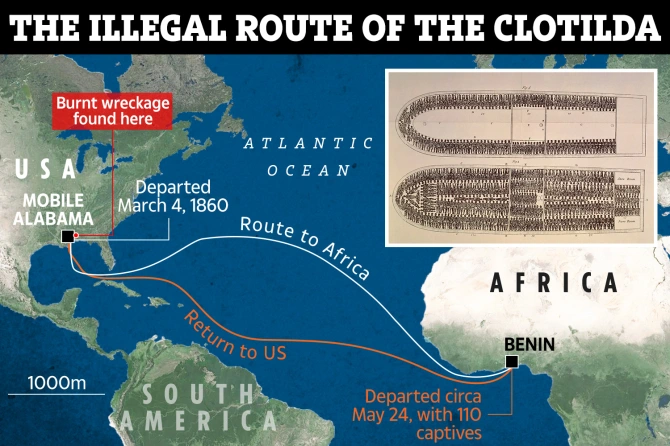
The Clotilda’s voyage was illegal because it proceeded despite an 1807 law making it illegal to import new slaves from Africa. Steamboat captain Timothy Meaher bet that his ship could make the trip anyway and took measures to disguise the Clotilda’s true intent. Later, Meaher and his confederates tried to burn the vessel to escape prosecution. The fire did not fully consume the ship, but burned enough for the owners to avoid punishment. (Credit: The Sun, Britain)
“And at one point in this journey, Cudjo describes being chained to the anchor chain with everyone else. I’m sure they didn’t know that they were about to be cast overboard, but that’s the kind of conditions they were in. Just horrific, at the edge of death every minute, hard to imagine. And by the time they were on the ship, it had been a month since they were captured. . . .
“At one point, he described that the Dahomans took the heads of everyone they killed as war trophies, and he describes seeing people he knew, their heads being smoked over a fire. So that’s what’s in his mind during the time he’s chained to the deck of this ship. It’s almost unbearable to think about the life of horrors that would leave you with.”
The Africans brought to Mobile showed remarkable cohesion, possibly because they all came from the same village. The anecdote is told of an overseer whipping a woman, prompting her to let out a shriek that brought the rest of the enslaved to her aid, attacking the overseer. “No one whipped an African [woman] after that,” Cudjo said.
Later, the Africans organized a community modeled after their villages in Dahomey, purchasing parcels from their villainous landowner.
As Raines continues, “Africa Town prospered from the 1900s forward early because it was a place apart from white Mobile, so all these businesses were big factories that came to town and those provided jobs. So that town grew and grew; by 1912 it was the fourth-biggest community in American governed by African Americans.
“By the 1950s and 1960s, more than 10,000 people were working the jobs, driving nice brick homes, everybody’s driving new cars . . . .”
Then came environmental racism of the kind that has victimized Black communities from Tulsa to St. Paul, Minn., and points east and west, north and south.
Authorities built a six-lane Interstate through the heart of the community, destroying buildings and businesses. “In 2000, the paper mills closed. And the International Paper Mill on the edge of Africatown was the largest paper mill in the world. So, in a heartbeat, thousands of the jobs were taken from the community as well because many people in Africatown worked there. Couple that with the crack epidemic, and Africatown was just left in shambles by the end of the 1990s. And there are fewer than 2,000 people there today and no businesses. The entire business district is gone.”
For years, the paper company spewed ash, soot and other material that contained dioxins and furans, known cancer-causing agents. Residents filed a class-action suit, settling in 2020 for paltry amounts.
Raines went to Benin, where he discovered a reckoning in progress over its role in the transatlantic slave trade.
Everybody there was part of that trade, either as slaver or enslaved.
Unlike in the West, African slavery was not passed down from generation to generation, and the enslaved were said to be considered part of the family. Africans used the term “deported” to describe those who were captured and sent away. “Slavery was something that happened once they reached America or Brazil,” said one official.
Still, the consequences were horrific and shameful, and slavery remains a point of contention between African Americans and Africans, as well as among citizens of Benin.
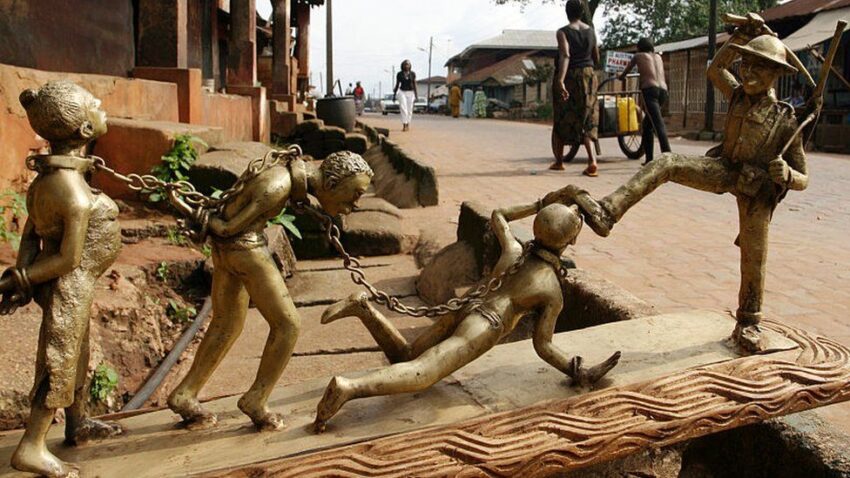
Raines wrote for the Mobile weekly Lagniappe, “I understood the concerns expressed by multiple government officials regarding how the country’s slaving past was portrayed.
“The creation of . . . new museums, and a push to attract tourists to the most important slavery sites means walking a fine line as the government simultaneously embraces the past and tries to assuage tribal resentments generations in the making. They fear, with some reason, that descendants of Dahomey’s victims might seek revenge in the modern age, and worry about promoting the darkest parts of the story.
“The fears are real. The Rwandan genocide of the 1990s was born of tribal resentments. The current chaos in Nigeria begins at the border, just 7 miles from Benin’s capital Porto Novo. Less than a week after I left Benin, the Islamist extremist group Boko Haram beheaded 13 kidnapped Christians in Nigeria. . . .”
Raines continued, “They are trying to have a national reconciliation. When you ride around Benin, there are monuments of people lost to slavery all over, and they are brutal. You’ll see a life-size person on a pedestal as you are driving down the road and that person is gagged, handcuffed and chained on their knees. It’s a lifelike statue in the heart of town. You will see walls where there are severed limbs all over them. Representing people lost to slavery. You’ll walk around and see statues with heads down and no face. And that’s meant to shame the living for their role in slavery.
“So I was stunned to find — here in America we are talking about reparations these days, and whether people who are descendants of enslaved people should be given something for the lives that were stolen from their ancestors. They are having that kind of conversation in Benin, too. And it’s exactly the same issue — slavery. The president of Benin was attacked in the last election because he has slave dealers in his family tree. You could see that wound is still there, in a way I have never understood or anticipated when I got there; it was quite remarkable.”
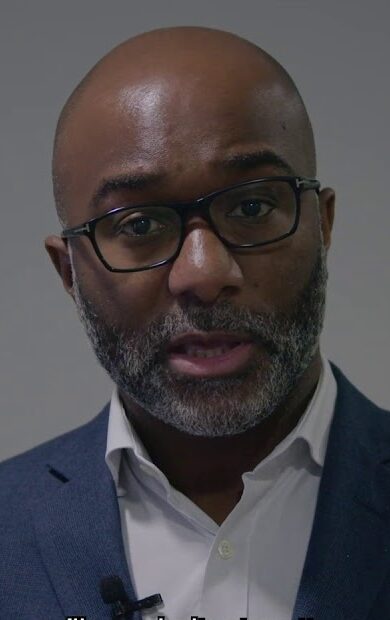 In Benin, Pastor Romain Zannou (pictured) recounted a visit to the United States in the early 1990s in which he detected a coolness that stemmed from the belief that Africans were to blame for selling American Blacks into slavery, Raines wrote in his book. “Zannou began apologizing to Americans for the actions of his forebears. He found that it opened a pathway to new friendships. He realized that the same sort of healing was needed within Benin, for descendants there on each side of the slavery divide.”
In Benin, Pastor Romain Zannou (pictured) recounted a visit to the United States in the early 1990s in which he detected a coolness that stemmed from the belief that Africans were to blame for selling American Blacks into slavery, Raines wrote in his book. “Zannou began apologizing to Americans for the actions of his forebears. He found that it opened a pathway to new friendships. He realized that the same sort of healing was needed within Benin, for descendants there on each side of the slavery divide.”
When African American pastors later went to a village in Benin, “They said, we have come to forgive you whose ancestors sold our ancestors. We can’t keep fighting among ourselves,” Zannou recounted. That forgiveness “opened the door for the two tribes to begin speaking to one another. Today, thirty years later, all of the children in the village attend school together, regardless of tribe, and the divide has disappeared.”
The film airs Feb. 7 on the National Geographic Channel at 10 p.m. EST, and starts streaming on Hulu and Disney+ the next day.
Reconciliation should also be a watchword on this side of the Atlantic. As the Guardian noted in reviewing Raines’ book, “In much the same terms as whites disdained them, African Americans ridiculed and ostracized the Clotilda captives and their offspring. They denounced them as ignorant, savage and ape-like. It’s little wonder their descendants came to lose the language of their ancestors and often to deny their heritage too.
In 2019, Michael Foster, whose great-great-great grandfather was the brother of the captain who led the Clotilda expedition, reached out to apologize to the descendants of the enslaved. Raines arranged the meeting. Foster’s trepidation was such that he removed his wedding ring “in case anyone wanted some kind of revenge against me for what my ancestor did.”
There was hugging, crying and forgiveness, Raines wrote.
Now the dreams are for the ship to be restored, put on display and to spark a boom in the economy along what is called the Civil Rights Trail, linking 110 landmarks in 14 states and Washington D.C. The Clotilda would be one of the trail’s attractions.
“That ship should be dug up and put on display in a world-class museum in Africatown,” Raines said on C-SPAN. “So, there were 20,000 ships in the slave trade; less than — 13 have been found, counting Clotilda. Most of them were ships that sank in ports. None of them were involved in the American slave trade.
“In the Smithsonian’s African American History Museum in Washington — fantastic museum — they have a piece of a slave ship on display, but it’s a South African ship that sank in port in Brazil. Never involved in the American trade, and the piece they have is about the size of a brick. Here we have an entire ship, the contents are still in it — the casks and everything that was on it. We need to dig the ship up and put it on display in a museum in Africatown, a world-class museum.
“The new lynching museum in Montgomery, Ala., has generated a billion-dollar impact on the local economy. Imagine having the last slave ship on display, when we have everything I spoke about with the legacy of the people. We know everything about all the families that came from it, the people who were on the ship, so imagine that museum.
“Meanwhile, as we’re unable to get . . . the state of Alabama to commit to digging it up, building it . . . [the] Smithsonian and the French government are building two new ships in Benin, $25 million apiece, to talk about that country’s slavery-era history. How on earth can Benin, one of the poorest countries in the world, have two $25 million museums, and Africatown, home to the people stolen from Benin with the last slave ship — how can we not have a museum there?”
Such a museum might also give a boost to Africatown and to African Americans around the country.
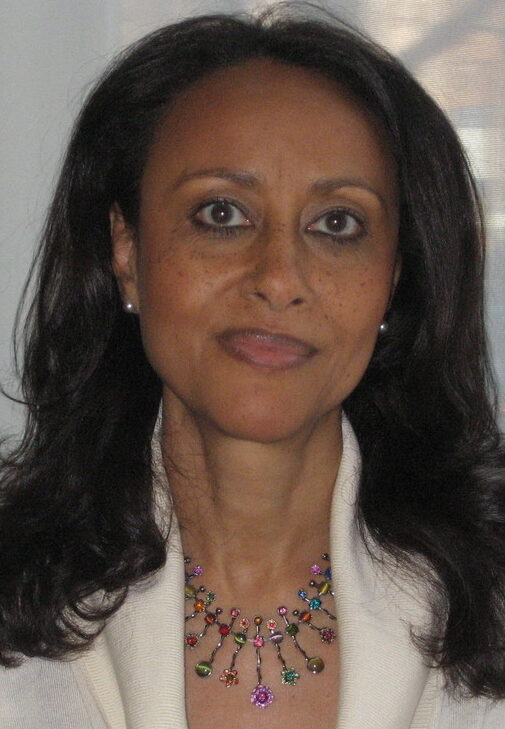 Historian Sylviane A. Diouf’s (pictured) 2007 book “Dreams of Africa in Alabama” was an inspiration for Raines’ exposition.
Historian Sylviane A. Diouf’s (pictured) 2007 book “Dreams of Africa in Alabama” was an inspiration for Raines’ exposition.
“There is a real urgency in preserving Africatown, not only for the people who are heirs to an exceptional part of African, African American and American history, but also for others. . . .,” Diouf wrote then. “Africatown descendants know for sure who their African ancestors were, from where they left, and when they arrived. They are the only ones with an African Town to call their own, and they are eager to share.”
As for Raines, he told C-SPAN, “As a journalist, what I want more than anything is to write something that changes people’s lives, that helps, and I don’t think I could ever come up with anything I could ever do again that would have the power and potential that this story has had.
“So I just want to get back out there and see what else we can find and what else we could do. And I guess the answer is, who knows?”
- Matthew Barakat, Associated Press: Committee controlled by Dems kills Youngkin education bills
- Molly Beck, Milwaukee Journal Sentinel: Evers vetoes bill that would have barred school lessons on systemic racism
- Darrin Bell cartoon, Washington Post
- Jamelle Bouie, New York Times: We Still Can’t See American Slavery for What It Was (Jan. 28)
- Hillary Chabot, Northeastern University: Why this journalist embraces critical race theory (Oct. 28)
- Dignity Justified: Clotilda and Africatown: Voices of the Clotilda: Africatown: Joycelyn Davis
- Charlotte Edwards, the Sun, U.K.: SHAME REMAINS Wreck of last slave ship that ferried 100s of captives from Africa to the US illegally found off Alabama coast (May 23, 2019)
- Lynn Elber, Associated Press: TV marks Black History Month with provocative, creative fare
- Mike Freeman, USA Today: ’28 Black Stories in 28 Days’ still needed two years after murder of George Floyd
- Peniel E. Joseph, CNN: Black History Month exposes the fallacy of White ‘discomfort’
- National Geographic: National Geographic Dives Into the Untold History of the Transatlantic Slave Trade with New Podcast, Into the Depths, Launching Jan. 27 (Jan. 13)
- NBCUniversal: NBCUniversal News Group Commemorates Black History With Cross-Platform Coverage Showcasing Black Heritage and Culture
- Ben Raines, Los Angeles Times: The Clotilda is the only American slave ship ever found. It needs to be preserved (July 17, 2019)
- Ben Raines with Mary Louise Kelly, NPR: The Clotilda, Last Known Ship To Bring Slaves To The U.S., Discovered In Alabama (May 23, 2019)
- Ben Raines, al.com: Wreck found by reporter may be last American slave ship, archaeologists say (Jan. 23, 2018, updated; Mar. 06, 2019)
- Ben Raines, Lagniappe Weekly: Benin and back again (Dec 31, 2019)
- Jay Reeves, Associated Press: Research: Wreck of last US slave ship mostly intact on Alabama coast (Dec. 22)
- A.E. Rooks, Daily Beast: Did You Study the Slave Trade in School or Were You Out That Day?
- Nichelle Smith, USA Today: In the crucible of historic change, I grew up Black and proud
- Michael Paul Williams, Richmond (Va.) Times-Dispatch: Gov. Youngkin’s “critical race theory” order is the epitome of systemic racism. Leave MLK out of it. (Jan. 18)
- Cleve R. Wootson Jr., Washington Post: Trump and allies try to redefine racism by casting White men as victims
To subscribe at no cost, please send an email to journal-isms+subscribe@groups.io and say who you are.
Facebook users: “Like” “Richard Prince’s Journal-isms” on Facebook.
Follow Richard Prince on Twitter @princeeditor
Richard Prince’s Journal-isms originates from Washington. It began in print before most of us knew what the internet was, and it would like to be referred to as a “column.” Any views expressed in the column are those of the person or organization quoted and not those of any other entity. Send tips, comments and concerns to Richard Prince at journal-isms+owner@
View previous columns (after Feb. 13, 2016).
View previous columns (before Feb. 13, 2016)
- Diversity’s Greatest Hits, 2018 (Jan. 4, 2019)
- Book Notes: Is Taking a Knee Really All That? (Dec. 20, 2018)
- Book Notes: Challenging ’45’ and Proudly Telling the Story (Dec. 18, 2018)
- Book Notes: Get Down With the Legends! (Dec. 11, 2018)
- Journalist Richard Prince w/Joe Madison (Sirius XM, April 18, 2018) (podcast)
- Richard Prince (journalist) (Wikipedia entry)
- February 2018 Podcast: Richard “Dick” Prince on the need for newsroom diversity (Gabriel Greschler, Student Press Law Center, Feb. 26, 2018)
- Diversity’s Greatest Hits, 2017 — Where Will They Take Us in the Year Ahead?
- Book Notes: Best Sellers, Uncovered Treasures, Overlooked History (Dec. 19, 2017)
- An advocate for diversity in the media is still pressing for representation, (Courtland Milloy, Washington Post, Nov. 28, 2017)
- Morgan Global Journalism Review: Journal-isms Journeys On (Aug. 31, 2017)
- Diversity’s Greatest Hits, 2016
- Book Notes: 16 Writers Dish About ‘Chelle,’ the First Lady
- Book Notes: From Coretta to Barack, and in Search of the Godfather
- Journal-isms’ Richard Prince Wants Your Ideas (FishbowlDC, Feb. 26, 2016)
- “JOURNAL-ISMS” IS LATEST TO BEAR BRUNT OF INDUSTRY’S ECONOMIC WOES (Feb. 19, 2016)
- Richard Prince with Charlayne Hunter-Gault, “PBS NewsHour,” “What stagnant diversity means for America’s newsrooms” (Dec. 15, 2015)
- Book Notes: Journalists Follow Their Passions
- Book Notes: Journalists Who Rocked Their World
- Book Notes: Hands Up! Read This!
- Book Notes: New Cosby Bio Looks Like a Best-Seller
- Journo-diversity advocate turns attention to Ezra Klein project (Erik Wemple, Washington Post, March 5, 2014)
When you shop @AmazonSmile, Amazon will make a donation to Journal-Isms Inc. https://t.co/OFkE3Gu0eK
— Richard Prince (@princeeditor) March 16, 2018

